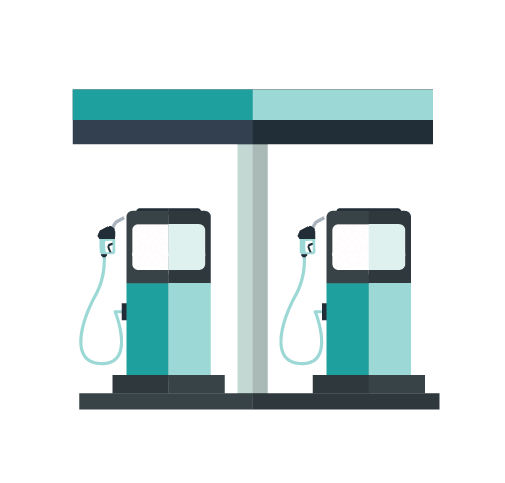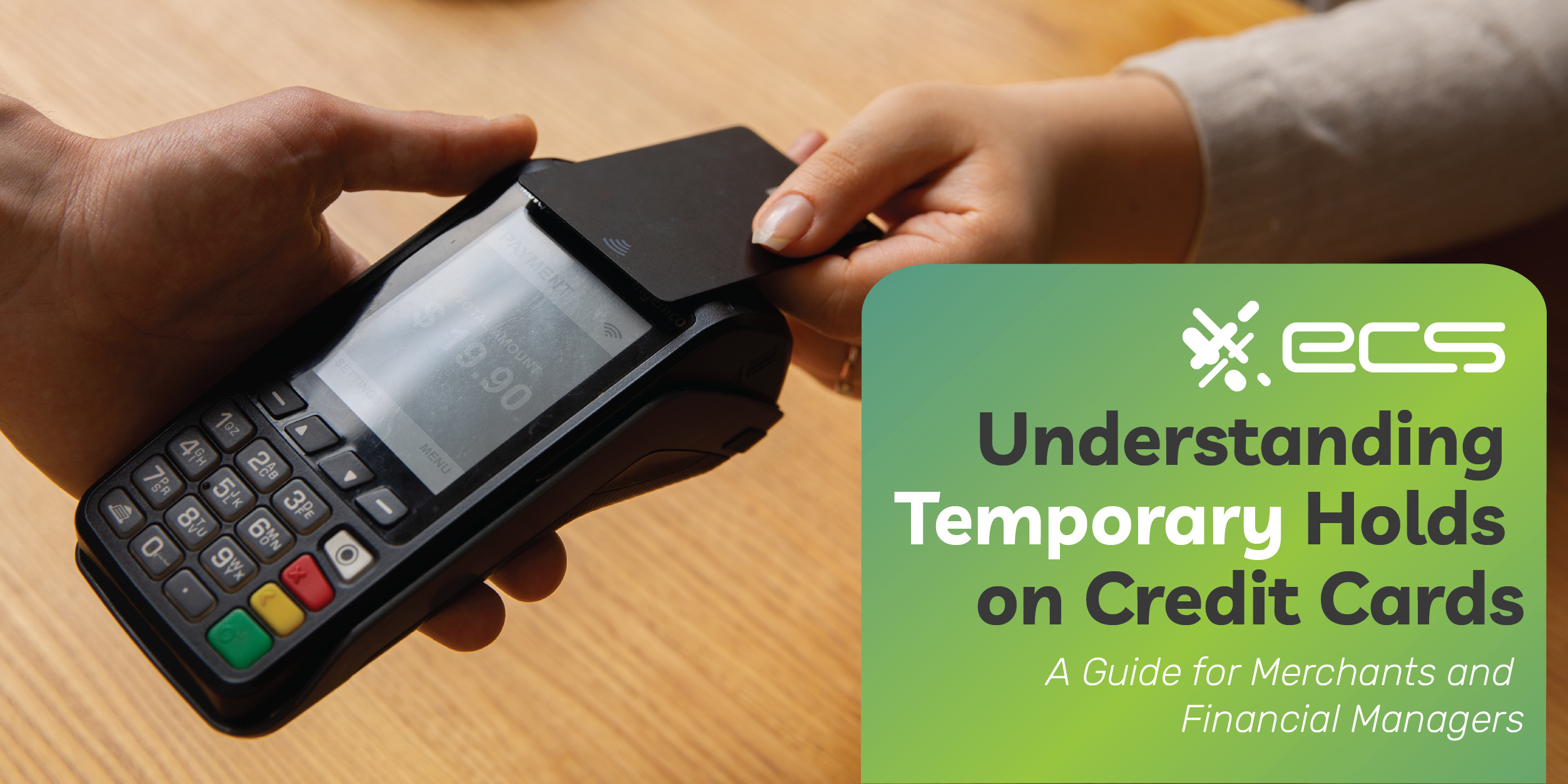Most people have been on the receiving end of a temporary hold on their credit card, at least for a partial amount. This is very common when checking into a hotel or renting a car. But what does it look like on the business end? Let’s look at credit card hold management for businesses.
We’ll examine how holds work on the back end and how customers perceive them. We’ll also examine what steps you can take to make temporary holds more palatable for them. Not every business uses temporary holds. But if your business is in the hospitality sector (food, hotels, travel) or anything that involves shipping, holds are particularly relevant.
What is a Temporary Hold on a Credit Card?
A temporary hold reduces the available credit on a card, almost like a purchase. However, unlike a purchase, it does not represent the actual transfer and settlement of funds from the cardholder to the merchant.
The main purpose of the hold is to prevent the cardholder from using those funds for other purchases. Often, the hold represents a proverbial “foot in the door” as a sort of placeholder until the actual cost of the transaction is finalized.
There are, in general, two types of holds: authorization holds and administrative holds. These two types of holds are issued for different reasons and have different repercussions.
Authorization holds are often used to verify that a customer’s credit card is in good standing and that they have available credit to cover a potential purchase. In the hospitality industry, businesses use authorization holds as a security deposit to cover the cost of potential damages to (or incidentals for) a hotel room or rental car.
How Temporary Holds on Credit Cards Work
Understanding temporary holds requires understanding how credit card charges work in general. Transactions have two parts: authorization and settlement. With a temporary hold, the business initiated an authorization, but they do not settle the transaction at that point. A temporary hold is possible because authorization and settlement do not occur simultaneously.
Let’s look at the process behind a normal credit card charge. When a customer pays with a credit card, the payment gateway or POS terminal helps the merchant’s payment processor verify that there are enough funds—or available credit—to make the purchase. At this point, the customer’s bank or card issuer agrees to “freeze” those funds by deducting them from their available credit.
But no payments change hands at this point. This doesn’t happen until the merchant and/or payment processor instructs the POS or payment gateway to submit finalized transactions as part of a “batch transfer.” If the merchant does not submit these requests, the temporary hold will linger until they cancel it. If they don’t, the card network will eventually bump it off (after 30 days).

Temporary Holds in Hospitality
Authorization holds are common in the hospitality industry. At check-in, a hotel might request a credit card to place a hold of a few hundred dollars for the duration of a guest’s stay as a security deposit. If the guest takes anything from the room (beyond the alluringly free sample-sized toiletries), the hotel can subtract the cost of that item from the amount of money returned to the cardholder’s credit card after checkout. If they damage any property, they may forfeit the entire security deposit.
This type of authorization hold is not as much about verifying the customer’s financial solvency as it is about collecting fees for incidentals and discouraging theft or damages. However, some hotels specifically require using credit cards (not debit cards) for a deposit as a screening tool because obtaining a credit card requires a good credit history, which may screen out risky guests. It also may have more funds available than a customer’s debit account.

Temporary Holds at Gas Stations
Sometimes, gas stations place authorization holds to verify the legitimacy of a card and its available credit. The amount of this hold may vary—they could authorize a charge ranging from $1 to $100. This is just to verify that the card is working. Once the customer is done pumping gas, the transaction amount will be finalized for batch transfers later in the day.

Temporary Holds in Restaurants
Restaurants are another place where authorization holds are common. Although the food has a fixed price, there is no way of knowing how much the customer will leave for a tip. The restaurant’s payment processor may authorize holds of 20% beyond the total bill—finalizing the actual sale once the server or manager has input the tip amount the customer left. Some restaurants post signage that if no tip (or an insufficient tip) is left, they will apply an 18% gratuity (or something similar).
Temporary Hold on a Credit Cards Impact on Available Credit
As explained, an authorization hold reduces a cardholder’s available credit. If they are paying with a debit card, it reduces the amount of cash available for purchases. Although it’s a technical subtlety, the actual balance of their account is not impacted until settlement.
At this point, we should touch on the other common type of hold—the administrative hold. In contrast to the authorization hold, which the merchant initiates at the time of the transaction, a cardholder’s bank issues administrative holds.
An administrative hold is not about assessing available credit or seeing if a card is legitimate. Rather, it is a response to fraudulent or suspicious activity. It may also be a punitive response to cardholder behavior, such as exceeding the credit limit or missing too many payments.
That said, an administrative hold does not involve taking a certain amount away from the cardholder’s available credit. It simply means shutting the card down or turning off access to the line of credit. Usually, the cardholder must contact the card issuer to verify that a transaction is not fraudulent.
If the administrative hold was issued due to nonpayment or exceeding the credit limit, the customer may need to make a payment to bring the account current again or reduce the balance back below the credit limit.
Duration of Temporary Holds
Holds on credit cards typically last between one and eight days. However, a merchant can leave an authorization lingering for up to 30 days before the card networks bump it off. Visa and MasterCard both encourage their merchants to release hold promptly, but aside from the 30-day mark, they do not have hard rules about how long a merchant can let an authorization linger.
The time an authorization lasts depends in part on the type of transaction and the merchant. Most service-based businesses, particularly in the hospitality sector, understand that leaving unresolved holds for an excessive amount of time creates a negative customer experience.
Most customers can expect an authorization charge to disappear or resolve into a final amount one day after the service is rendered or completed. For instance, a diner will typically see a finalized charge the day after eating at a restaurant. A hotel guest may see a security deposit fall off—minus the subtracted cost of any incidentals—the day after checkout.
High Risk Transactions
Sometimes a high-risk transaction will see an authorization charge last longer than the usual timeframe. Large purchases, international transactions, and telephone orders may come with longer holds—until the bank vets the charge or the shipped item is in transit. Purchases made in the context of certain industries, like online gambling or adult entertainment, can also trigger longer authorization holds.
Processing and Banking Cutoff Times
The timing of a transaction may also impact hold times. Purchases made before or on a weekend may have a longer hold since the merchant may not finalize transactions until the arrival of a business day.
Your bank and the type of card used may also impact hold times. Oftentimes, credit cards have longer turnarounds for authorization holds than debit cards. This is partly because the debit card is directly tied to your tangible bank account balance.
Also, banking institutions realize that holds can prevent customers from accessing their cash balances. This motivates them to clear the hold more quickly to avoid creating an inconvenience that would drive their depositors elsewhere.
Laws and Best Practices Concerning Temporary Holds on Credit Cards
There aren’t any federal laws about authorization holds and/or disclosure to customers. However, your state or county might have specific requirements about signage. Your local Chamber of Commerce is a good resource to find out if there are any local ordinances about authorizations you must adhere to.
Your business should have clear and timely policies about releasing holds on a customer’s card. You may be able to work with your payment processor to create automatic triggers so that holds do not have to be manually released. However, there may be some contexts in which a degree of manual involvement in releasing the hold is unavoidable.
Corporations tend to create policies that foster greater transparency around preauthorizations, like security deposits. For instance, a hotel chain may have a standard practice of posting visible signage about a standard deposit at check-in. We’ll look at that in the next section.
But how can a restaurant automatically impose an 18% gratuity on your bill? From the federal angle, the IRS categorizes this charge as a service fee rather than a tip. However, at the state level, many states have laws requiring transparent communication to customers about such an authorization.
Tips, on the other hand, are processed differently. Customers write down the dollar amount they want to leave as a tip on their card before exiting. The server then has to manually input this number at the end of a shift or the end of the night.
However, certain trends in the payment landscape may eliminate the need for authorization holds entirely. Restaurants that use QR codes for payment allow customers to add a tip and pay through an online gateway. This single-step process immediately finalizes the transaction, removing the need for an authorization hold.
Managing Customer Expectations With Temporary Holds
Communicating authorization holds to your customers in advance fosters trust. Many customers may be unaware of how these holds work or why they’re even necessary. Educating them, however, can significantly enhance their experience.
A well-designed hold notification ensures that your customers understand why the hold is being placed, how long the funds may be unavailable, and are aware of any factors that could impact the final charge, such as additional services or fees.
When customers feel informed, they’re more likely to view your business as professional and considerate, even if a temporary hold inconveniences them. This proactive and transparent approach prevents potential frustration and misunderstandings that could escalate into negative customer reviews and reduces the likelihood of disputes or chargebacks.

Examples of Hold Notifications
Here’s an example of some verbiage a hotel might use to avoid a negative customer experience:
“To ensure your reservation, we may place a temporary authorization hold on your credit or debit card for the estimated total cost of your stay, plus an additional amount for incidentals.
“This hold is temporary and will typically be released within 1-3 business days after departure. However, the release time may vary depending on your bank’s processing time.
“Please note that any charges incurred during your stay, such as room service or minibar usage, will be added to your final bill.”
Better Understanding Proper Hold Notifications
Let’s break down some of this verbiage and see how it facilitates a better customer experience. First, the authorization’s intended purpose is communicated clearly: to secure your reservation. This aligns with what the customer wants.
Next— the hotel clearly spells out what could impact the final settled cost of the authorization: incidentals. Then, the hotel provides a timeframe for the release and return of the hold. However, it outlines a caveat to avoid further frustrations: this timeframe may be longer depending on your bank or a card issuer.
The hotel then adds some additional information about incidentals—like room service or minibar usage. If you’re going to take pint-sized bottles of alcohol from the fridge and a tiny bag of peanuts, you can expect to pay $20.
This example applies specifically to hotels, but you can fit the general principles into almost any business that will place authorization holds on a customer’s credit card.
Understanding Temporary Hold Frustrations
Keep in mind that authorization holds are a common cause of customer frustration. Many customers do not understand the idea of an authorization hold. If a customer is in a tight financial place, authorization holds can create a chain reaction of financial problems, like bounced bills, overdraft accounts, and unavailable credit.
If a customer already had other negative experiences, a lingering authorization hold can become the proverbial cherry on top, or the straw that broke the camel’s back. “My room smelled like cigarettes, the pool was closed—and you charged me $100 extra!” Later, when the charge falls off, it’s unlikely that they’ll change their Yelp review, especially if the rowdy room next door kept them up all night.
In addition to forbidding exorcisms in your business location, be proactive about communicating authorizations before a transaction. If a customer becomes too frustrated by a lingering authorization, they may even initiate a chargeback dispute with their bank, which could cost you the sale entirely and add additional fees.
Conclusion
A credit card hold is a temporary authorization a merchant places on a customer’s account to reserve funds for an impending transaction. Industries like hospitality and car rentals, where the final charge amount may not be known upfront, commonly use this practice. Holds serve as a safeguard for businesses to ensure that funds are available when they finalize the transaction.
However, if not managed properly, holds can lead to customer frustration. Customers may struggle to differentiate between a credit card hold and an actual charge. If a hold lasts longer than a day, they may become upset and dispute the transaction with their bank. To avoid these issues, it’s essential to adhere to card hold best practices, comply with regulations, be transparent with your customers, and finalize transactions promptly. By managing credit card holds effectively, you can protect your business while ensuring a positive customer experience.
Learn more about how ECS Payments can help you set up better payment processing solutions for your business. Fill out our contact form or send us an email at info@ecspayments.com.
Frequently Asked Questions About Temporary Holds on Credit Cards
Preauthorization charges and temporary holds are closely related. Preauthorization charges are a type of temporary hold placed by merchants to confirm a card’s validity and available funds to cover incidentals and damages. Temporary holds are a broader term that includes preauthorizations and other holds (like fraud checks). These holds reduce the available credit on a card, serving as a placeholder for potential charges.
Temporary holds on credit cards are frequently used in hospitality (e.g., hotels for security deposits), car rentals, gas stations (to verify card functionality), and restaurants (to accommodate tips or service charges). They are also used for online orders and high-value or international transactions.
Temporary holds still require authorization, same as a standard credit card transaction. However, the hold is not automatically settled to the merchant when they batch out their sales for the day. No funds are transferred to the merchant unless the transaction is finalized by manually processing the payment on hold. If the hold is not finalized, it will eventually be returned to the cardholder.
Temporary holds usually last between 1 and 8 days. However, it can extend to 30 days if the merchant does not manually release it. The duration depends on the type of transaction, the merchant’s policies, and the cardholder’s bank processing times. High-risk transactions or those occurring over weekends may also have longer holds.
Businesses should be transparent and communicate hold policies proactively. Providing details about why the hold is placed, its duration, and how it might affect available credit helps manage customer expectations. Visible signage, clear verbal explanations, and timely hold releases foster trust and reduce the likelihood of credit card disputes or negative reviews.
